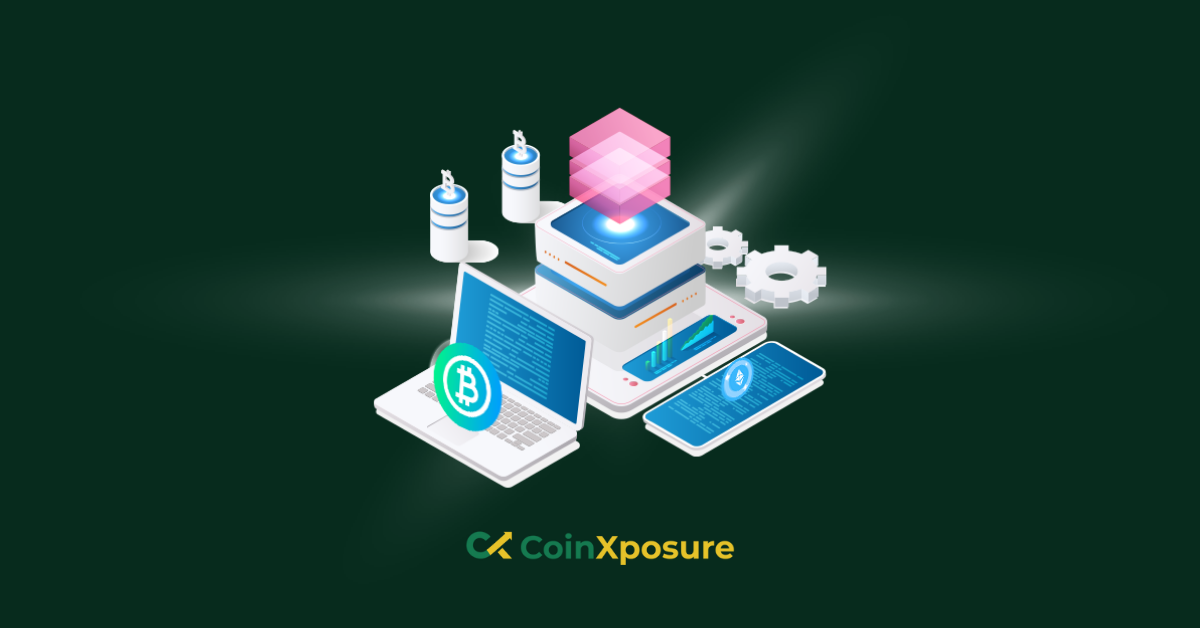
The Mechanisms Behind Decentralized Perpetual Swaps
Decentralized perpetual swaps have emerged as a cornerstone of the burgeoning decentralized finance (DeFi) landscape, offering traders a novel way to speculate on asset prices without the need for traditional intermediaries.
These financial instruments combine the flexibility of perpetual contracts with the security and transparency of blockchain technology, revolutionizing the way derivatives are traded.
In this exploration, we delve into the mechanisms that underpin decentralized perpetual swaps, uncovering the intricate interplay of smart contracts, decentralized order books, funding rates, and collateralization.
By understanding these mechanisms, we can grasp the transformative potential of decentralized perpetual swaps in reshaping the future of finance.
General Overview of Decentralized Finance (DeFi)
Decentralized finance, or DeFi, represents a paradigm shift in the way financial services are built, accessed, and utilized. It leverages blockchain technology to create an open, permissionless, and transparent ecosystem of financial applications and protocols that operate without the need for traditional intermediaries like banks or brokers.
At its core, DeFi aims to democratize finance by providing anyone with an internet connection access to a wide range of financial services, including lending, borrowing, trading, asset management, derivatives, and more. Key characteristics of DeFi include:
- Decentralization
- Interoperability
- Accessibility
- Transparency
- Permissionless Innovation
Decentralization
DeFi platforms are built on blockchain networks, such as Ethereum, and operate using smart contracts – self-executing code that automatically enforces the terms of agreements. This eliminates the need for centralized authorities and intermediaries, reducing counterparty risk and enhancing transparency.
Interoperability
DeFi protocols are designed to be interoperable, meaning they can seamlessly interact and integrate with each other. This interoperability enables composability, allowing developers to combine different DeFi building blocks to create more complex financial products and services.
Accessibility
DeFi is open to anyone with an internet connection and a cryptocurrency wallet, enabling individuals worldwide to access financial services that were previously inaccessible or exclusive.
This inclusivity promotes financial inclusion and empowerment, particularly in regions with limited access to traditional banking infrastructure.
Transparency
DeFi operates on public blockchain networks, where all transactions and smart contract code are visible and auditable by anyone. This transparency fosters trust among users and reduces the risk of fraud or manipulation.
Permissionless Innovation
DeFi protocols are permissionless, meaning anyone can build, deploy, and interact with them without needing approval from centralized authorities. This fosters a culture of innovation, allowing developers to experiment with new ideas and iterate rapidly.
Despite its transformative potential, DeFi also faces challenges such as scalability, security, regulatory compliance, and user experience. However, as the ecosystem continues to mature and evolve, DeFi has the potential to revolutionize traditional finance, making it more efficient, inclusive, and resilient.
Understanding Perpetual Swaps
Perpetual swaps are a type of derivative contract that allows traders to speculate on the price movement of an underlying asset without owning it. Unlike traditional futures contracts, perpetual swaps do not have an expiration date, making them ideal for traders who want to maintain their positions indefinitely.
These contracts are designed to closely track the price of the underlying asset by using a funding mechanism that adjusts the contract’s value to match the spot price. This mechanism ensures that the perpetual swap’s price remains in line with the market price of the underlying asset, minimizing the risk of arbitrage opportunities.
Traders can go long (buy) or short (sell) perpetual swaps, depending on their market outlook. Long positions profit from an increase in the price of the underlying asset, while short positions profit from a decrease in price.
Perpetual swaps are traded on leverage, allowing traders to amplify their exposure to the underlying asset. This enables traders to maximize their potential profits, but it also increases the risk of losses. To mitigate this risk, exchanges typically require traders to maintain a minimum margin in their trading accounts.
Perpetual swaps offer traders a flexible and efficient way to gain exposure to the price movements of various assets, without the need to own or store the underlying asset.
However, they also come with inherent risks, including volatility, leverage, and liquidation risks, which traders should carefully consider before participating in these markets.
Mechanisms Behind Decentralized Perpetual Swaps
Decentralized perpetual swaps rely on several key mechanisms to facilitate trading without the need for traditional intermediaries:
- Smart Contracts
- Decentralized Order Books
- Funding Rates
- Collateralization and Margin Requirements
Smart Contracts
Smart contracts are self-executing contracts with the terms of the agreement directly written into code. In the context of decentralized perpetual swaps, smart contracts automate trade execution and settlement.
They hold the funds of both parties involved in the swap and ensure that trades are executed according to predefined rules without the need for a centralized exchange or clearinghouse.
Decentralized Order Books
Decentralized order books match buy and sell orders from users in a peer-to-peer manner. These order books are maintained on a blockchain network and are accessible to anyone.
By using decentralized order books, traders can submit orders directly to the network without relying on a centralized exchange to match their trades.
Funding Rates
Funding rates are periodically exchanged between long and short positions in decentralized perpetual swaps to ensure that the contract’s price closely tracks the underlying asset’s spot price.
These funding rates are calculated based on the difference between the perpetual swap’s price and the spot price of the underlying asset. If the perpetual swap’s price is higher than the spot price, long positions pay funding to short positions, and vice versa.
Collateralization and Margin Requirements
To participate in decentralized perpetual swaps, traders are required to collateralize their positions with a certain amount of cryptocurrency.
This collateral acts as security against potential losses and ensures that traders have sufficient funds to cover their positions. Margin requirements dictate the minimum amount of collateral needed to open and maintain a position, helping to manage risk and prevent default.
By leveraging these mechanisms, decentralized perpetual swaps enable traders to speculate on the price movements of various assets in a permissionless, secure, and transparent manner, without relying on centralized intermediaries.
However, it’s essential for traders to understand the risks involved, including volatility, liquidation, and smart contract vulnerabilities, before engaging in decentralized perpetual swap trading.
Advantages of Decentralized Perpetual Swaps
Decentralized perpetual swaps offer several advantages over their centralized counterparts:
- Accessibility and Permissionless Trading
- Security and Transparency
- Lower Fees
- 24/7 Trading
- Censorship Resistance
Accessibility and Permissionless Trading
Decentralized perpetual swaps are accessible to anyone with an internet connection and a cryptocurrency wallet. There are no geographic restrictions or account requirements, allowing users from around the world to participate in trading without needing approval from centralized authorities.
Security and Transparency
Decentralized perpetual swaps are built on blockchain technology, which provides a high level of security and transparency.
Transactions are recorded on a public ledger that is immutable and auditable by anyone, reducing the risk of fraud or manipulation. Additionally, smart contracts automate trade execution and settlement, eliminating the need for trust in third-party intermediaries.
Lower Fees
Decentralized perpetual swaps typically have lower fees compared to centralized exchanges. Since there are no intermediaries involved, traders can avoid fees associated with order matching, custody, and withdrawal. This can result in significant cost savings, especially for frequent traders or those trading with large volumes.
24/7 Trading
Decentralized perpetual swaps operate on blockchain networks that are accessible 24/7, allowing traders to trade anytime, anywhere, without being limited by market hours or time zones.
This flexibility is particularly beneficial for traders who want to take advantage of opportunities in volatile markets or react quickly to breaking news.
Censorship Resistance
Decentralized perpetual swaps are censorship-resistant, meaning that transactions cannot be censored or blocked by third parties. This ensures that traders have full control over their funds and can trade without fear of interference from governments or other authorities.
Decentralized perpetual swaps offer a more inclusive, secure, and cost-effective way for traders to gain exposure to the price movements of various assets, without relying on centralized intermediaries.
However, it’s important for traders to conduct thorough research and understand the risks involved before engaging in decentralized perpetual swap trading.
Challenges of Decentralized Perpetual Swaps
While decentralized perpetual swaps offer numerous benefits, they also present several challenges:
- Scalability Issues
- Regulatory Uncertainty
- Risk Management and Volatility
- Smart Contract Vulnerabilities
- Liquidity Constraints
- User Experience
- Oracle Reliability
Scalability Issues
Many decentralized platforms face scalability limitations, particularly those built on Ethereum, due to network congestion and high gas fees. As a result, transactions may be slow or costly during periods of high demand, impacting the trading experience for users.
Regulatory Uncertainty
The regulatory landscape surrounding decentralized finance (DeFi) and perpetual swaps is still evolving. Regulatory agencies around the world are increasingly scrutinizing DeFi platforms, which could lead to compliance challenges, restrictions, or even shutdowns in certain jurisdictions.
Risk Management and Volatility
Decentralized perpetual swaps are highly leveraged financial instruments that magnify both potential profits and losses. Traders must manage their risk carefully to avoid liquidation, particularly during periods of high volatility in the underlying asset’s price.
Smart Contract Vulnerabilities
Smart contracts are susceptible to bugs, vulnerabilities, and exploits, which could result in financial losses for users. While audits and security best practices can help mitigate these risks, they cannot eliminate them entirely, and users must remain vigilant.
Liquidity Constraints
Liquidity is crucial for the efficient functioning of decentralized perpetual swaps. However, liquidity on decentralized platforms can be fragmented, leading to wider bid-ask spreads and slippage. Additionally, low liquidity can increase the risk of market manipulation and flash crashes.
User Experience
Decentralized platforms may have a steeper learning curve and less intuitive user interfaces compared to centralized exchanges. This can deter mainstream adoption and limit the accessibility of decentralized perpetual swaps to less tech-savvy users.
Oracle Reliability
Decentralized perpetual swaps rely on oracles to obtain accurate price feeds for the underlying assets. However, oracles can be vulnerable to manipulation or inaccuracies, which could lead to incorrect pricing and liquidations.
Addressing these challenges will be essential for the continued growth and adoption of decentralized perpetual swaps, as well as the broader DeFi ecosystem.
Collaborative efforts among developers, regulators, and users will be crucial to overcome these obstacles and realize the full potential of decentralized finance.
Conclusion
Decentralized perpetual swaps represent a groundbreaking innovation in the realm of decentralized finance (DeFi), offering traders unparalleled access, security, and flexibility in trading financial derivatives.
By leveraging smart contracts, decentralized order books, and funding mechanisms, these platforms enable permissionless trading of perpetual contracts without the need for traditional intermediaries.
Despite their numerous advantages, decentralized perpetual swaps also face challenges such as scalability issues, regulatory uncertainty, risk management concerns, liquidity constraints, and user experience hurdles. Addressing these challenges will be essential for the continued growth and adoption of decentralized finance and perpetual swaps.
As the DeFi ecosystem evolves and matures, decentralized perpetual swaps have the potential to revolutionize the way derivatives are traded, democratizing access to financial markets and empowering individuals worldwide.
However, it’s crucial for traders to conduct thorough research, understand the risks involved, and stay informed about regulatory developments to navigate this rapidly evolving landscape safely.
With careful consideration and collaboration among stakeholders, decentralized perpetual swaps can continue to push the boundaries of innovation and reshape the future of finance.





